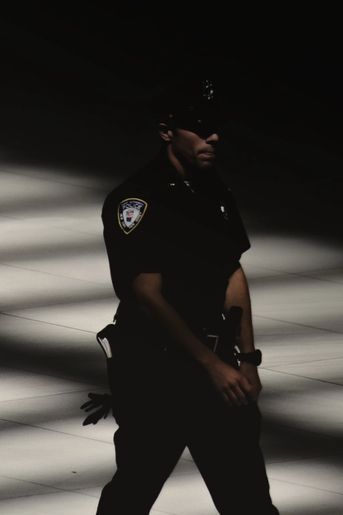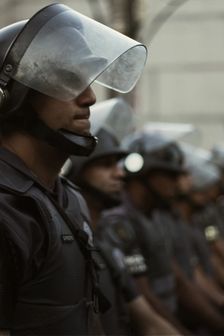The Police Chief
In this section, you'll learn about the responsibilities of a police chief, their scope of influence over police misconduct, and what's behind the blue wall of silence.

MEET THE TOP COP WHO RUNS YOUR CITY
America’s policing approach is pretty fragmented. That’s partially because we have federal, state, county, and local police departments. This tiered structure is meant to allow community issues to be resolved on the local level, but it’s also led to inconsistent standards.
There’s very little federal guidance on policing, which means local departments make their own rules. There are over 18,000 national, state, and local police departments in the US. Each one has different laws to enforce. They also tackle training, recruitment, and management in a variety of ways.
If you’ve followed a high profile investigation on national or local news you’ve probably heard a police chief in a briefing. They are the top law enforcer for a municipality and responsible for their police force.
Their responsibilities include:
- Supervising daily operations of their police departments
- Managing internal and external investigations
- Hiring, assessing, disciplining, and firing personnel
- Interpreting and upholding codes, laws, and ordinances
- Developing policies and procedures in line with city council guidelines
- Planning department budgets with the city manager
- Conducting press briefings and meetings with politicians
Note: Some towns have a sheriff instead of a police chief. If you have a sheriff in your community learn more about their responsibilities and how to hold them accountable.
Source: GovtJobsHow do they get into office?
They are usually appointed by the mayor or other city officials. Sheriffs are elected officials and usually have limited restrictions on their power.
What’s their relationship with police misconduct?
Police chiefs are the first line of defense against misconduct since they are responsible for setting policies as well as disciplining and firing police officers who commit crimes or break department rules. A police chief sets the tone of their department.
When a distinct pattern of misconduct appears in a police department, it’s usually a symptom of embedded corruption at a higher level. This means supervisors are looking away.
THE HARD TRUTH
While they do hold a lot of responsibility, the truth is police chiefs have some limitations on how they can hold officers accountable. This is due to powerful union contracts that can override their firing decisions. These contracts can require a police chief to rehire officers that were previously fired for misconduct.
A micro case study: Philadelphia, PA and Washington, DC
Between 2006 and 2017, Philadelphia and DC had to rehire 80 fired officers. In a "Washington Post" interview, former Philadelphia police commissioner and DC chief Charles H. Ramsey said:
It’s demoralizing, but not just to the chief...it’s demoralizing to the rank and file who really don’t want to have those kinds of people in their ranks... it causes a tremendous amount of anxiety in the public. Our credibility is shot whenever these things happen.
Source: Washington Post
Each of these departments had union contracts that guaranteed appeals for disciplinary measures. Most of the rehired officers were even awarded back pay for the period of time they were fired. Guess who pays for that? We do.
THE BLUE WALL OF SILENCE
You’ve probably heard the term before.
The “Blue Wall of Silence” is an unspoken code that officers remain silent when a fellow officer is accused of misconduct. There’s a sense of loyalty baked into the concept: officers protect and support one another, both on the beat and in the office. Even if they are guilty.
The “Blue Wall of Silence” has created a toxic, tribalist culture. Whistleblowers get harassed. Bad actors walk free. Misconduct is covered up by colleagues.
This code is apparently strong enough to incite officers to lie even when they have little to lose by telling the truth,” choosing instead to risk their careers.
Source: Chicago Tribune
When good officers do speak up, there are very few mechanisms in place to protect them from retaliation. In fact, officers that challenge toxic behavior are typically socially shunned and excluded so they stay silent. Here's a personal essay from a former police officer based in California detailing the toxic environment in the police force. There's also a third-party cliff notes version on Instagram. The interesting thing to note: the fellow officers in the comments confirming his confessions about the culture.
When police reforms are put in place they are frequently met with friction. There’s also very little being done to ensure departments are held accountable. This creates the perfect environment for misconduct to breed and fester into corruption over time if it goes unchecked.
Ultimately police chiefs are responsible for the culture of their departments, but the force has a long history of being resistant to organizational change.
Officers must completely reconsider their purpose and prioritize the humanity in the people they serve to effectively reform a police department. This requires actually going back to their core mission of protecting civilians.
The scale of the toxicity is woven so deeply into the core of how officers operate that a lot of citizens, organizers, and activists believe the current policing system is beyond repair.
Source: The AtlanticExtra Credit
One of the biggest challenges with tracking police violence is that victims are too scared to report it because they fear retaliation or inaction. Without visibility and transparency, the problem stays in the shadows.

